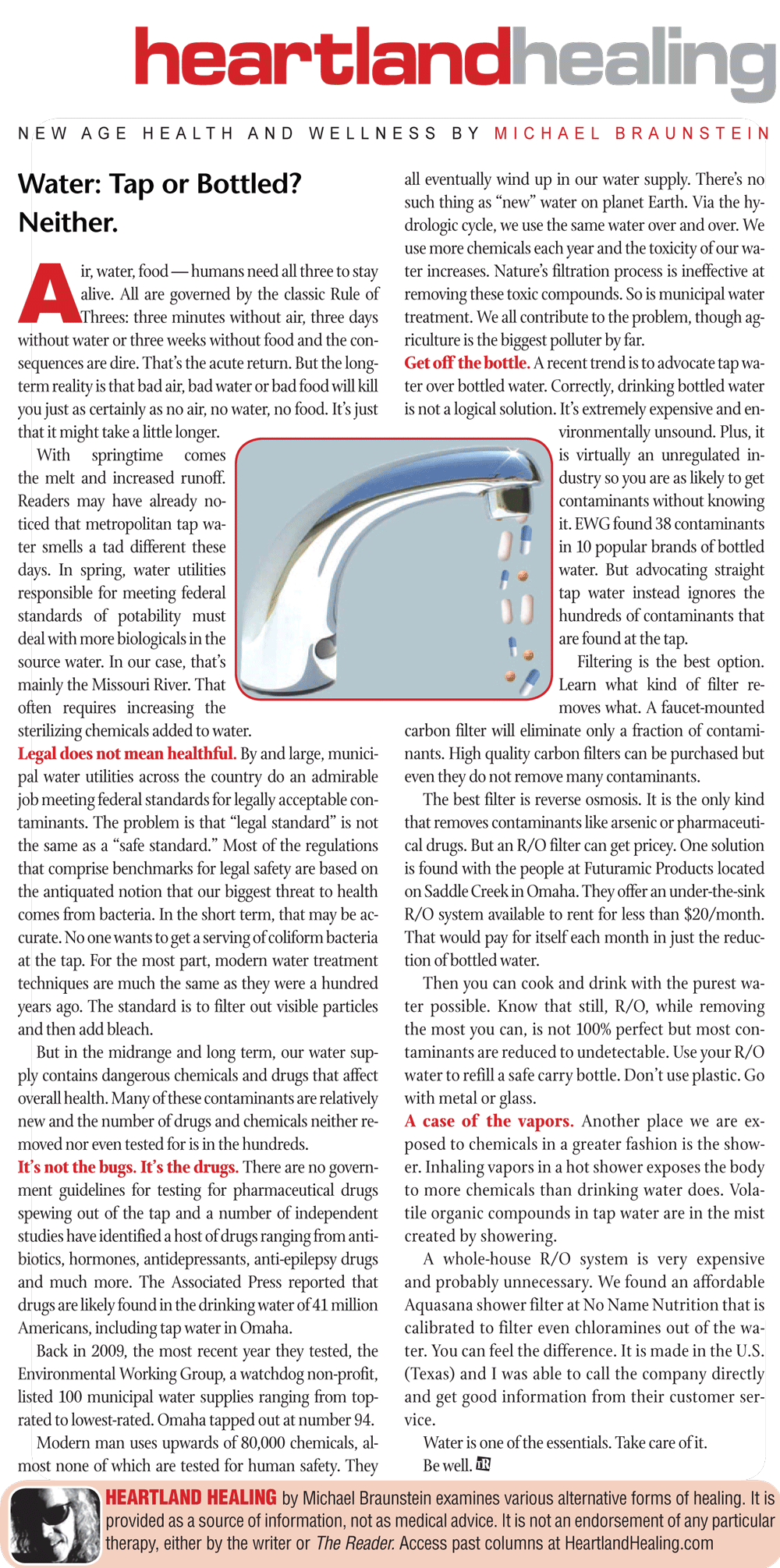|
||||||
| Back to Column Archives | ||||||
WATER: TAP OR BOTTLED? NEITHER! Air, water, food — humans need all three to stay alive. All are governed by the classic Rule of Threes: three minutes without air, three days without water or three weeks without food and the con- sequences are dire. That’s the acute return. But the long- term reality is that bad air, bad water or bad food will kill you just as certainly as no air, no water, no food. It’s just that it might take a little longer. With springtime comes the melt and increased runoff. Readers may have already noticed that metropolitan tap water smells a tad different these days. In spring, water utilities responsible for meeting federal standards of potability must deal with more biologicals in the source water. In our case, that’s mainly the Missouri River. That Back in 2009, the most recent year they tested, the Environmental Working Group, a watchdog non-profit, listed 100 municipal water supplies ranging from top-rated to lowest-rated. Omaha tapped out at number 94. Modern man uses upwards of 80,000 chemicals, almost none of which are tested for human safety. They all eventually wind up in our water supply. There’s no such thing as “new” water on planet Earth. Via the hydrologic cycle, we use the same water over and over. We use more chemicals each year and the toxicity of our wa- ter increases. Nature’s filtration process is ineffective at removing these toxic compounds. So is municipal water treatment. We all contribute to the problem, though ag- riculture is the biggest polluter by far. Get off the bottle. A recent trend is to advocate tap wa- ter over bottled water. Correctly, drinking bottled water is not a logical solution. It’s extremely expensive and environmentally unsound. Plus, it is virtually an unregulated in- dustry so you are as likely to get contaminants without knowing it. EWG found 38 contaminants in 10 popular brands of bottled water. But advocating straight tap water instead ignores the hundreds of contaminants that are found at the tap. Filtering is the best option. Learn what kind of filter removes what. A faucet-mounted carbon filter will eliminate only a fraction of contaminants. High quality carbon filters can be purchased but even they do not remove many contaminants. The best filter is reverse osmosis. It is the only kind that removes contaminants like arsenic or pharmaceutical drugs. But an R/O filter can get pricey. One solution is found with the people at Futuramic Products located on Saddle Creek in Omaha. They offer an under-the-sink R/O system available to rent for less than $20/month. That would pay for itself each month in just the reduction of bottled water. Then you can cook and drink with the purest water possible. Know that still, R/O, while removing the most you can, is not 100% perfect but most contaminants are reduced to undetectable. Use your R/O water to refill a safe carry bottle. Don’t use plastic. Go with metal or glass. A whole-house R/O system is very expensive and probably unnecessary. We found an affordable Aquasana shower filter at No Name Nutrition that is calibrated to filter even chloramines out of the wa- ter. You can feel the difference. It is made in the U.S. (Texas) and I was able to call the company directly and get good information from their customer ser- vice. Water is one of the essentials. Take care of it. Be well. |
||||||
|
home • directory • feature column • column archives • news • hot links • calendar
Heartland Healing is devoted to the examination of various alternative forms of healing. It is provided as a source of information and not as medical advice. It is not meant as an endorsement of any particular therapy, either by the writer or by Heartland Healing Center, Inc. © 1997- Heartland Healing All Rights Reserved • Site by Omaha's Desktop Ad Shop |




